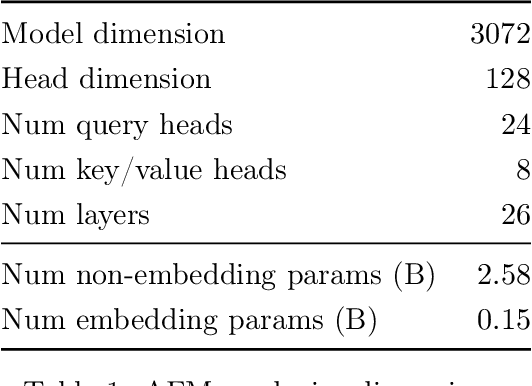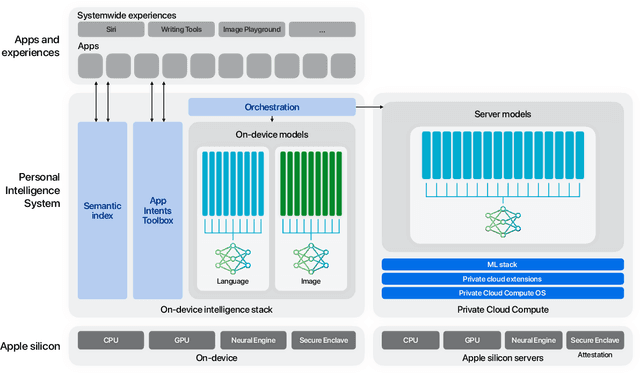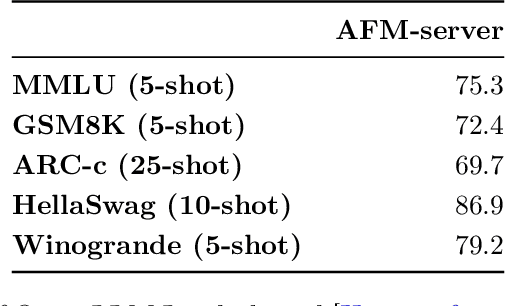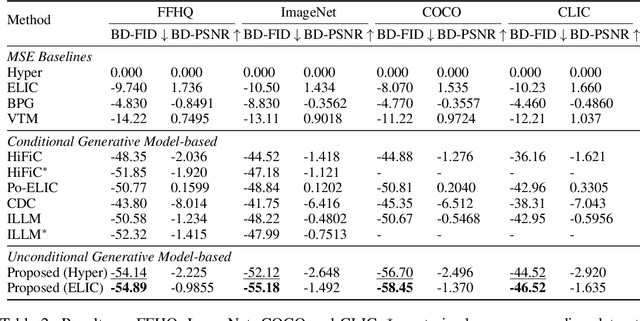Yanghao Li
Improve Vision Language Model Chain-of-thought Reasoning
Oct 21, 2024



Abstract:Chain-of-thought (CoT) reasoning in vision language models (VLMs) is crucial for improving interpretability and trustworthiness. However, current training recipes lack robust CoT reasoning data, relying on datasets dominated by short annotations with minimal rationales. In this work, we show that training VLM on short answers does not generalize well to reasoning tasks that require more detailed responses. To address this, we propose a two-fold approach. First, we distill rationales from GPT-4o model to enrich the training data and fine-tune VLMs, boosting their CoT performance. Second, we apply reinforcement learning to further calibrate reasoning quality. Specifically, we construct positive (correct) and negative (incorrect) pairs of model-generated reasoning chains, by comparing their predictions with annotated short answers. Using this pairwise data, we apply the Direct Preference Optimization algorithm to refine the model's reasoning abilities. Our experiments demonstrate significant improvements in CoT reasoning on benchmark datasets and better generalization to direct answer prediction as well. This work emphasizes the importance of incorporating detailed rationales in training and leveraging reinforcement learning to strengthen the reasoning capabilities of VLMs.
Distance between Relevant Information Pieces Causes Bias in Long-Context LLMs
Oct 18, 2024



Abstract:Positional bias in large language models (LLMs) hinders their ability to effectively process long inputs. A prominent example is the "lost in the middle" phenomenon, where LLMs struggle to utilize relevant information situated in the middle of the input. While prior research primarily focuses on single pieces of relevant information, real-world applications often involve multiple relevant information pieces. To bridge this gap, we present LongPiBench, a benchmark designed to assess positional bias involving multiple pieces of relevant information. Thorough experiments are conducted with five commercial and six open-source models. These experiments reveal that while most current models are robust against the "lost in the middle" issue, there exist significant biases related to the spacing of relevant information pieces. These findings highlight the importance of evaluating and reducing positional biases to advance LLM's capabilities.
MM-Ego: Towards Building Egocentric Multimodal LLMs
Oct 09, 2024



Abstract:This research aims to comprehensively explore building a multimodal foundation model for egocentric video understanding. To achieve this goal, we work on three fronts. First, as there is a lack of QA data for egocentric video understanding, we develop a data engine that efficiently generates 7M high-quality QA samples for egocentric videos ranging from 30 seconds to one hour long, based on human-annotated data. This is currently the largest egocentric QA dataset. Second, we contribute a challenging egocentric QA benchmark with 629 videos and 7,026 questions to evaluate the models' ability in recognizing and memorizing visual details across videos of varying lengths. We introduce a new de-biasing evaluation method to help mitigate the unavoidable language bias present in the models being evaluated. Third, we propose a specialized multimodal architecture featuring a novel "Memory Pointer Prompting" mechanism. This design includes a global glimpse step to gain an overarching understanding of the entire video and identify key visual information, followed by a fallback step that utilizes the key visual information to generate responses. This enables the model to more effectively comprehend extended video content. With the data, benchmark, and model, we successfully build MM-Ego, an egocentric multimodal LLM that shows powerful performance on egocentric video understanding.
EC-DIT: Scaling Diffusion Transformers with Adaptive Expert-Choice Routing
Oct 02, 2024



Abstract:Diffusion transformers have been widely adopted for text-to-image synthesis. While scaling these models up to billions of parameters shows promise, the effectiveness of scaling beyond current sizes remains underexplored and challenging. By explicitly exploiting the computational heterogeneity of image generations, we develop a new family of Mixture-of-Experts (MoE) models (EC-DIT) for diffusion transformers with expert-choice routing. EC-DIT learns to adaptively optimize the compute allocated to understand the input texts and generate the respective image patches, enabling heterogeneous computation aligned with varying text-image complexities. This heterogeneity provides an efficient way of scaling EC-DIT up to 97 billion parameters and achieving significant improvements in training convergence, text-to-image alignment, and overall generation quality over dense models and conventional MoE models. Through extensive ablations, we show that EC-DIT demonstrates superior scalability and adaptive compute allocation by recognizing varying textual importance through end-to-end training. Notably, in text-to-image alignment evaluation, our largest models achieve a state-of-the-art GenEval score of 71.68% and still maintain competitive inference speed with intuitive interpretability.
MM1.5: Methods, Analysis & Insights from Multimodal LLM Fine-tuning
Sep 30, 2024Abstract:We present MM1.5, a new family of multimodal large language models (MLLMs) designed to enhance capabilities in text-rich image understanding, visual referring and grounding, and multi-image reasoning. Building upon the MM1 architecture, MM1.5 adopts a data-centric approach to model training, systematically exploring the impact of diverse data mixtures across the entire model training lifecycle. This includes high-quality OCR data and synthetic captions for continual pre-training, as well as an optimized visual instruction-tuning data mixture for supervised fine-tuning. Our models range from 1B to 30B parameters, encompassing both dense and mixture-of-experts (MoE) variants, and demonstrate that careful data curation and training strategies can yield strong performance even at small scales (1B and 3B). Additionally, we introduce two specialized variants: MM1.5-Video, designed for video understanding, and MM1.5-UI, tailored for mobile UI understanding. Through extensive empirical studies and ablations, we provide detailed insights into the training processes and decisions that inform our final designs, offering valuable guidance for future research in MLLM development.
Byzantine-Robust and Communication-Efficient Distributed Learning via Compressed Momentum Filtering
Sep 13, 2024Abstract:Distributed learning has become the standard approach for training large-scale machine learning models across private data silos. While distributed learning enhances privacy preservation and training efficiency, it faces critical challenges related to Byzantine robustness and communication reduction. Existing Byzantine-robust and communication-efficient methods rely on full gradient information either at every iteration or at certain iterations with a probability, and they only converge to an unnecessarily large neighborhood around the solution. Motivated by these issues, we propose a novel Byzantine-robust and communication-efficient stochastic distributed learning method that imposes no requirements on batch size and converges to a smaller neighborhood around the optimal solution than all existing methods, aligning with the theoretical lower bound. Our key innovation is leveraging Polyak Momentum to mitigate the noise caused by both biased compressors and stochastic gradients, thus defending against Byzantine workers under information compression. We provide proof of tight complexity bounds for our algorithm in the context of non-convex smooth loss functions, demonstrating that these bounds match the lower bounds in Byzantine-free scenarios. Finally, we validate the practical significance of our algorithm through an extensive series of experiments, benchmarking its performance on both binary classification and image classification tasks.
Apple Intelligence Foundation Language Models
Jul 29, 2024



Abstract:We present foundation language models developed to power Apple Intelligence features, including a ~3 billion parameter model designed to run efficiently on devices and a large server-based language model designed for Private Cloud Compute. These models are designed to perform a wide range of tasks efficiently, accurately, and responsibly. This report describes the model architecture, the data used to train the model, the training process, how the models are optimized for inference, and the evaluation results. We highlight our focus on Responsible AI and how the principles are applied throughout the model development.
Idempotence and Perceptual Image Compression
Jan 17, 2024



Abstract:Idempotence is the stability of image codec to re-compression. At the first glance, it is unrelated to perceptual image compression. However, we find that theoretically: 1) Conditional generative model-based perceptual codec satisfies idempotence; 2) Unconditional generative model with idempotence constraint is equivalent to conditional generative codec. Based on this newfound equivalence, we propose a new paradigm of perceptual image codec by inverting unconditional generative model with idempotence constraints. Our codec is theoretically equivalent to conditional generative codec, and it does not require training new models. Instead, it only requires a pre-trained mean-square-error codec and unconditional generative model. Empirically, we show that our proposed approach outperforms state-of-the-art methods such as HiFiC and ILLM, in terms of Fr\'echet Inception Distance (FID). The source code is provided in https://github.com/tongdaxu/Idempotence-and-Perceptual-Image-Compression.
Bandwidth-efficient Inference for Neural Image Compression
Sep 07, 2023



Abstract:With neural networks growing deeper and feature maps growing larger, limited communication bandwidth with external memory (or DRAM) and power constraints become a bottleneck in implementing network inference on mobile and edge devices. In this paper, we propose an end-to-end differentiable bandwidth efficient neural inference method with the activation compressed by neural data compression method. Specifically, we propose a transform-quantization-entropy coding pipeline for activation compression with symmetric exponential Golomb coding and a data-dependent Gaussian entropy model for arithmetic coding. Optimized with existing model quantization methods, low-level task of image compression can achieve up to 19x bandwidth reduction with 6.21x energy saving.
Conditional Perceptual Quality Preserving Image Compression
Aug 16, 2023Abstract:We propose conditional perceptual quality, an extension of the perceptual quality defined in \citet{blau2018perception}, by conditioning it on user defined information. Specifically, we extend the original perceptual quality $d(p_{X},p_{\hat{X}})$ to the conditional perceptual quality $d(p_{X|Y},p_{\hat{X}|Y})$, where $X$ is the original image, $\hat{X}$ is the reconstructed, $Y$ is side information defined by user and $d(.,.)$ is divergence. We show that conditional perceptual quality has similar theoretical properties as rate-distortion-perception trade-off \citep{blau2019rethinking}. Based on these theoretical results, we propose an optimal framework for conditional perceptual quality preserving compression. Experimental results show that our codec successfully maintains high perceptual quality and semantic quality at all bitrate. Besides, by providing a lowerbound of common randomness required, we settle the previous arguments on whether randomness should be incorporated into generator for (conditional) perceptual quality compression. The source code is provided in supplementary material.
 Add to Chrome
Add to Chrome Add to Firefox
Add to Firefox Add to Edge
Add to Edge